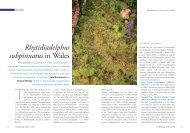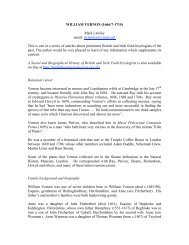London's changing bryophyte flora
London's changing bryophyte flora
London's changing bryophyte flora
Create successful ePaper yourself
Turn your PDF publications into a flip-book with our unique Google optimized e-Paper software.
(5a) (6a) (6c)<br />
(5b)<br />
The <strong>changing</strong> bryo<strong>flora</strong> of London The <strong>changing</strong> bryo<strong>flora</strong> of London<br />
n Fig. 5. Epiphytes. (a) Sloping ash trunk at Moat Mount with a fine<br />
colony of Frullania dilatata and tufts of Ulota bruchii, U. crispa and<br />
U. phyllantha (b). J.G. Duckett<br />
D. montanum has spread onto the trunks of<br />
living trees. D. tauricum is now frequent on a<br />
variety of both dead and living trees in woodlands<br />
throughout the London area (Fig. 6c).<br />
The recent discovery of Nowellia curvifolia on<br />
a decorticated log on Stanmore Common is<br />
matched by Ken Adams finding it recently in<br />
Epping Forest. Similarly, it was only a matter of<br />
time before Lophocolea semiteres was discovered<br />
on Hampstead Heath in 2009 given its abundance<br />
in Epping Forest to the east and in Surrey<br />
to the south-west of London.<br />
JGD still remembers Jack Gardiner’s delight<br />
when, in 1983, Frullania dilatata was found for<br />
(6b)<br />
the first time in the 20th century in Middlesex<br />
in Ruislip Woods (Gardiner & Bowlt, 1983).<br />
Today, it is common in sheltered wooded areas<br />
throughout the London area (Fig. 5a), as are<br />
Orthotrichum lyellii (Fig. 6b), Ulota bruchii, U.<br />
crispa and Cryphaea heteromalla, the last species<br />
almost always with numerous sporophytes and<br />
often forming patches over 10 cm in diameter.<br />
Ulota phyllantha is also frequent at three sites<br />
(Hampstead Heath, Bentley Priory and Moat<br />
Mount) on sloping turkey oak, ash and willow<br />
trunks (Fig. 5a). There are fewer records from<br />
south of the river, but sightings of all five species<br />
in the last 4 years on Barnes Common, and in<br />
Dulwich Park and Crystal Palace Park, indicate<br />
centripetal spreading since Jack Gardiner’s 1981<br />
Surrey <strong>flora</strong>, like that seen in Middlesex. In fact,<br />
Jack in 1981 noted a decrease in Cryphaea since<br />
Ted Wallace described it as occurring all along<br />
the (North) Downs in 1941 (Wallace, 1941); in<br />
1981 it had very few extant localities and those<br />
were all restricted to the far south of Surrey. Since<br />
it was first recorded as an epiphyte on Hampstead<br />
Heath in the 1990s Grimmia pulvinata has<br />
become widespread on a variety of trees in the<br />
London area. Radula complanata, found for<br />
the first time on Hampstead Heath by Alan<br />
Harrington in 2005, is also increasing, but not<br />
quite as dramatically as Metzgeria consanguinea<br />
and M. violacea. It is now common at Stanmore,<br />
Loxley Green, Scratchwood and on Hampstead<br />
Heath to see these two species, together with<br />
another rapidly spreading new arrival, Zygodon<br />
conoideus, completely clothing sallow branches<br />
v Fig. 6. Epiphytes. (a) Sallows in the grounds<br />
of Stanmore Orthopaedic Hospital with trunks<br />
covered with Zygodon conoideus and patches of<br />
Radula complanata. (b) Highly tomentose colony<br />
of Orthotrichum lyellii at Scratchwood. (c) Sloping<br />
birch, Sandy Heath, Hampstead covered with<br />
Dicranum tauricum, D. montanum, Dicranoweisia<br />
cirrata, Hypnum andoi, Lophocolea heterophylla<br />
and L. semiteres. (d) Moss-covered bole at the base<br />
of a Prunus in Hugo Road, Tufnell Park. (e) A close<br />
up view showing Syntrichia papillosa growing with<br />
Orthotrichum diaphanum and Grimmia pulvinata, now<br />
a common epiphyte on a variety of trees in London.<br />
J.G. Duckett<br />
and trunks (Fig. 6a). Such a vast increase in<br />
abundance is probably the consequence of a<br />
series of wet summers, as is the unusual sight<br />
of M. violacea growing as an epiphyll on ivy on<br />
Hampstead Heath (Duckett, 2008b).<br />
An interesting feature of the two Metzgeria<br />
species is that, unlike the exogenous gemmae<br />
in most leafy liverworts (Duckett & Ligrone,<br />
1995), these are endogenous in origin (Ligrone<br />
& Duckett, 1993). This is a novel morphological<br />
feature that supports the most recent totalevidence<br />
liverwort phylogenies that closely<br />
link Metzgeria with the Aneuraceae (Forrest et<br />
al., 2006; Crandall-Stotler et al., 2008). The<br />
pale colour of the thalli of Riccardia incurvata,<br />
illustrated here for comparison with Metzgeria<br />
(Fig. 7a–d), is due to most of the upper surface<br />
of mature thalli being made up of the empty<br />
cell walls remaining after gemma liberation.<br />
The multicellular foliar gemmae in Radula are<br />
also endogenous in origin but, considering the<br />
near-crown group position of the Radulaceae,<br />
this is almost certainly a derived feature in<br />
the Jungermanniidae. In gemmiferous Radula,<br />
portions of the leaf margins are also caducous.<br />
On the theme of asexual reproduction<br />
Zygodon conoideus, Orthotrichum affine (see<br />
Goode et al., 1993 for a full description) and<br />
42 FieldBryology No98 | Jun09 FieldBryology No98 | Jun09 43<br />
(6d)<br />
(6e)
















